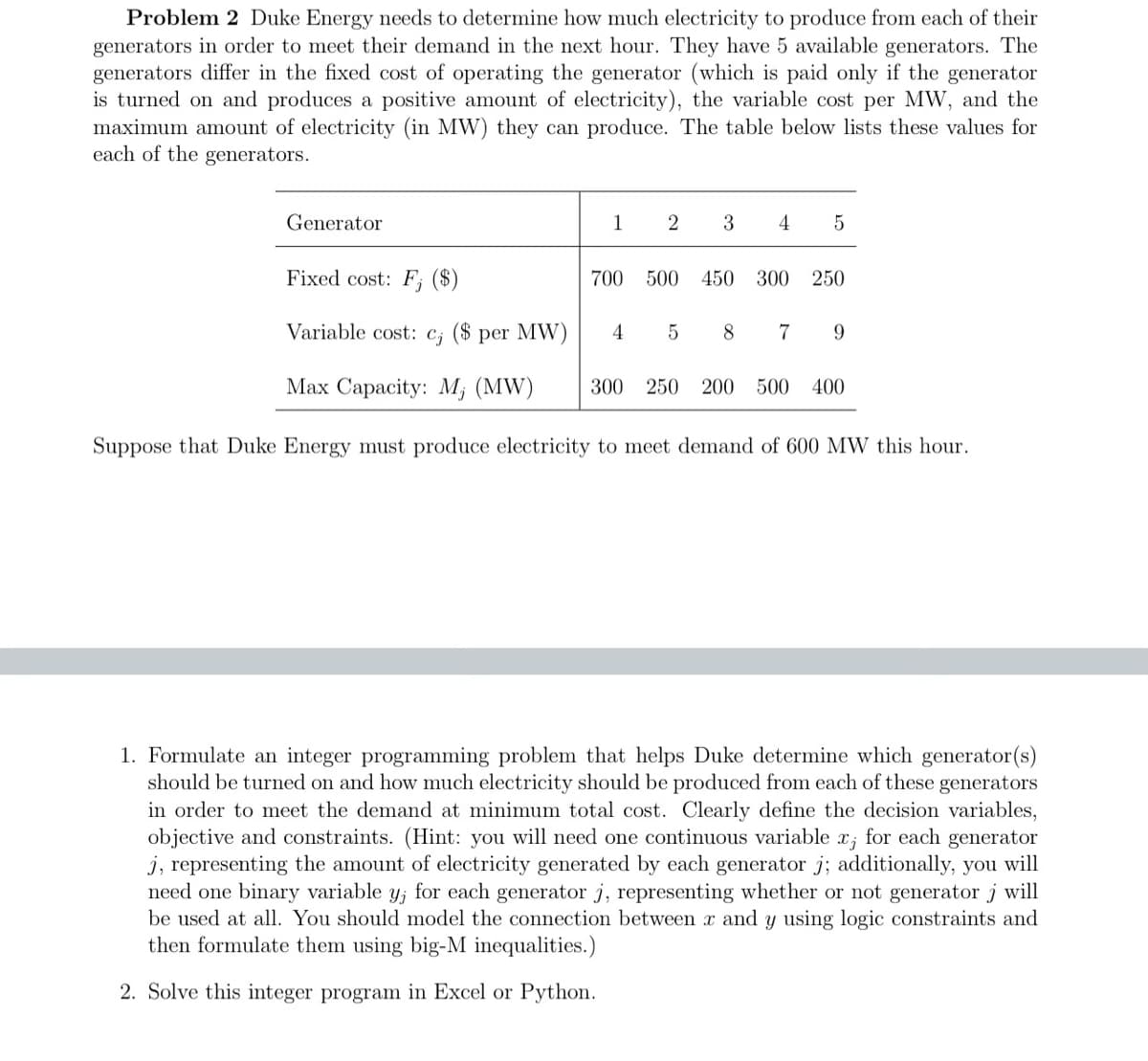Problem 2 Duke Energy needs to determine how much electricity to produce from each of their generators in order to meet their demand in the next hour. They have 5 available generators. The generators differ in the fixed cost of operating the generator (which is paid only if the generator is turned on and produces a positive amount of electricity), the variable cost per MW, and the maximum amount of electricity (in MW) they can produce. The table below lists these values for each of the generators. Generator 1 2 3 4 5 Fixed cost: F; ($) 700 500 450 300 250 Variable cost: c; ($ per MW) 4 8 7 9. Max Capacity: M; (MW) 300 250 200 500 400 Suppose that Duke Energy ust produce electricity to demand of 600 MW this hour. 1. Formulate an integer programming problem that helps Duke determine which generator(s) should be turned on and how much electricity should be produced from each of these generators in order to meet the demand at minimum total cost. Clearly define the decision variables, objective and constraints. (Hint: you will need one continuous variable ; for each generator j, representing the amount of electricity generated by each generator j; additionally, you will need one binary variable y; for each generator j, representing whether or not generator j will be used at all. You should model the connection between r and y using logic constraints and then formulate them using big-M inequalities.) 2. Solve this integer program in Excel or Python.
Problem 2 Duke Energy needs to determine how much electricity to produce from each of their generators in order to meet their demand in the next hour. They have 5 available generators. The generators differ in the fixed cost of operating the generator (which is paid only if the generator is turned on and produces a positive amount of electricity), the variable cost per MW, and the maximum amount of electricity (in MW) they can produce. The table below lists these values for each of the generators. Generator 1 2 3 4 5 Fixed cost: F; ($) 700 500 450 300 250 Variable cost: c; ($ per MW) 4 8 7 9. Max Capacity: M; (MW) 300 250 200 500 400 Suppose that Duke Energy ust produce electricity to demand of 600 MW this hour. 1. Formulate an integer programming problem that helps Duke determine which generator(s) should be turned on and how much electricity should be produced from each of these generators in order to meet the demand at minimum total cost. Clearly define the decision variables, objective and constraints. (Hint: you will need one continuous variable ; for each generator j, representing the amount of electricity generated by each generator j; additionally, you will need one binary variable y; for each generator j, representing whether or not generator j will be used at all. You should model the connection between r and y using logic constraints and then formulate them using big-M inequalities.) 2. Solve this integer program in Excel or Python.
Practical Management Science
6th Edition
ISBN:9781337406659
Author:WINSTON, Wayne L.
Publisher:WINSTON, Wayne L.
Chapter4: Linear Programming Models
Section: Chapter Questions
Problem 107P
Related questions
Question

Transcribed Image Text:Problem 2 Duke Energy needs to determine how much electricity to produce from each of their
generators in order to meet their demand in the next hour. They have 5 available generators. The
generators differ in the fixed cost of operating the generator (which is paid only if the generator
is turned on and produces a positive amount of electricity), the variable cost per MW, and the
maximum amount of electricity (in MW) they can produce. The table below lists these values for
each of the generators.
Generator
1
2
3
4
Fixed cost: F; ($)
700
500
450 300 250
Variable cost: c; ($ per MW)
4
8.
7
Max Capacity: M; (MW)
300
250 200 500
400
Suppose that Duke Energy must produce electricity to meet demand of 600 MW this hour.
1. Formulate an integer programming problem that helps Duke determine which generator(s)
should be turned on and how much electricity should be produced from each of these generators
in order to meet the demand at minimum total cost. Clearly define the decision variables,
objective and constraints. (Hint: you will need one continuous variable x; for each generator
j, representing the amount of electricity generated by each generator j; additionally, you will
need one binary variable y; for each generator j, representing whether or not generator j will
be used at all. You should model the connection between x and y using logic constraints and
then formulate them using big-M inequalities.)
2. Solve this integer program in Excel or Python.
Expert Solution
This question has been solved!
Explore an expertly crafted, step-by-step solution for a thorough understanding of key concepts.
This is a popular solution!
Trending now
This is a popular solution!
Step by step
Solved in 3 steps with 4 images

Recommended textbooks for you

Practical Management Science
Operations Management
ISBN:
9781337406659
Author:
WINSTON, Wayne L.
Publisher:
Cengage,

Practical Management Science
Operations Management
ISBN:
9781337406659
Author:
WINSTON, Wayne L.
Publisher:
Cengage,